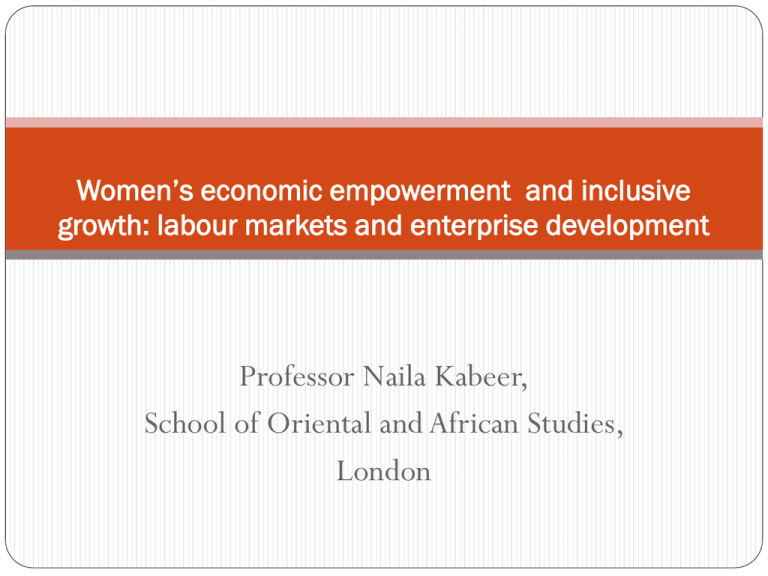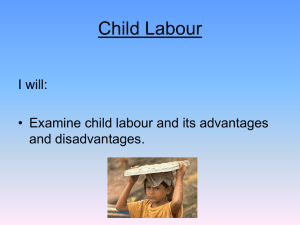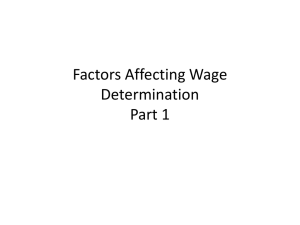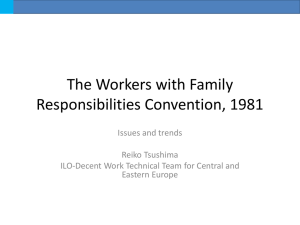
Women’s economic empowerment and inclusive
growth: labour markets and enterprise development
Professor Naila Kabeer,
School of Oriental and African Studies,
London
‘Inclusive’ growth implies opportunities for, and fruits of,
growth widely distributed
Rationale for explicit focus on women and girls lies in
asymmetrical relationship documented between economic
growth and gender equality.
Gender equality in education and employment – and under
certain circumstances wages – has a positive impact on
economic growth – for different choice of time periods and
different groups of countries
But economic growth has a far more mixed impact on gender
equality: either none or -in some case - adverse impacts
However economic growth found to be most positive when
accompanied by greater gender equality in employment and
education
Aims of paper
Discuss different ways of defining women’s economic
empowerment
Discuss different theoretical explanations of gender
inequality in labour market outcomes
Review empirical literature to identify key issues in analysis
of labour markets and enterprise from women’s
empowerment perspective, including blockages and barriers
to progress
Identify promising approaches to addressing blockages and
barriers
Identify possible questions that need future research
Feminist concerns with women’s
empowerment
Unequal power relations which blocked women’s capacity to exercise control
over their own lives and participate in wider society on equal terms
Focus on women’s subjectivity and consciousness (‘the power within’)
Importance of key resources (material, social and human) for achieving change
Strong collective dimension to achieving sustained structural change
Women not homogenous group: differentiated by context, class, caste, race etc
Practical gender needs and strategic gender interests
Conceptualising women’s
economic empowerment
World Bank Gender Equality Plan: ‘ Economic
empowerment is about making markets work for women (at
the policy level) and empowering women to compete (at the
agency level) 2007
ICRW: ‘a women is economically empowered when she has
both the ability to succeed and advance economically and the
power to make and act on economic decisions’ 2011
UNDP: women’s economic empowerment can be achieved
by targeting initiatives to expanding women’s economic
opportunity; strengthen their legal status and rights; and
ensure their voice, inclusion and participation in economic
decision-making (2008)
Conceptualising women’s economic
empowerment
OECD-DAC GENDERNET: women’s economic empowerment is
their capacity to participate in, contribute to and benefit from
growth processes in ways that recognise the value of their
contributions, respect their dignity and make it possible for them
to negotiate a fairer distribution of the benefits of growth (2011)
SIDA: ‘the process which increases women’s real power over
economic decisions that influence their lives and priorities in
society. Women’s economic empowerment can be achieved
through equal access to and control over critical economic
resources and opportunities, and the elimination of structural
gender inequalities in the labour market, including a better sharing
of unpaid care work (2009)
Overlaps and differences
Overlapping focus on markets for women’s labour
On agency and capabilities
Differences:
Means to achieve valued goals or valued goal in its own right
Confined to economic domain or spill-over into other
domains of life?
Role allocated to market:
Improving women’s competitiveness or fairer terms of
competition?
Limits to markets as force for transformative
change in women’s lives
Returning to OECD-DAC definition – our attempt to draw
attention to the ‘terms of engagement with market forces’:
recognition, dignity and strategic forms of agency
Based on literature that patterns of growth matter as much as
pace for reducing inequality
Market forces on their own cannot dissolve ‘durable
inequalities’ in the market place (WDR 2006)
Where market failures are norm rather than exception,
markets reproduce inequalities because underpinned by
asymmetries of power
Limits to markets as force for transformative change in
women’s lives
Those with power are able to frame ‘the rules of the game’ to defend
their privileges – or ignore the rules that they themselves framed
Example of former: Nyamu-Musembi on asymmetrical attention to
rights of capital relative to the rights of labour in rule of law reforms
Example of latter: Ravi Kanbur notes it is not existence of regulations
alone that distinguishes formal from informal employment but extent
to which regulations enforced (widespread violation of labour
regulations across the world)
We need to know better how markets work in the ‘real’ world,
particularly in low income countries and what leads to persistence of
gender inequalities
Theoretical approaches: individual choice
and structural constraint
Neo-classical theories assume individual choice and
control for largely individual constraints. Strong reliance
on econometric modelling
But ‘gender is more than a dummy variable’. Simply
factoring more variables to reduce the unexplained
portion of gender wage gap may reduce residual but
does not rule out discrimination. Shifts attention from
direct wage discrimination to processes which give rise
to inequalities in valued resource endowments and
different structure of rewards/opportunities
Feminist theories:
Links between gender-segregation and distribution of wages
(Treiman and Hartmann, 1981)
Bergmann’s ‘crowding’ hypothesis combined social
stereotyping/outright discrimination to explain segregated
market structure and operation of market forces to explain
distribution of wages and working conditions
Folbre (1994): Gendered structure of labour markets
product of behaviour of powerful actors promoting or
defending their privilege (employers exploiting divisions in
work force; established groups of labour excluding weaker
sections from competing in order to better their own wages
and working conditions etc)
Feminist approaches
Individuals and groups do make choices and exercise agency
but capacity to do so shaped by larger structures of constraint
which govern social relations between different groups in
different domains of society. Gender disadvantage in the
labour market is product of these structures of constraint
which operate over the life course of men and women in
different societies
Quantitative methods can help establish existence and
magnitude of inequality of outcomes but qualitative methods
needed to explain how and why
Gendered structures of constraint: gender
specific constraints (Kabeer, 2008)
Norms, beliefs and values arising from inherently gendered
relations of ‘private’ domain of family and kinship: ascribed roles
and responsibilities, aptitudes and predispositions on basis of
gender (age, marital status etc). Define prevailing models of
masculinity and femininity for different societies and different
social groups within them
Most widespread: primary responsibility for unpaid care and
domestic work ascribed to women and girls. Men largely assigned
primary responsibility in productive sphere but economic roles of
women vary across societies and, by class etc, within them
More context specific: norms restricting women’s mobility in
public domain, association of men and women with certain
technologies; crops etc
Gendered structures of constraint:
‘imposed’ gender constraints
Purportedly impersonal relations in state and market becoming
‘bearers of gender’ when they reflect and reinforce
preconceived notions of masculinity and femininity as routine
aspects of their rules, procedures and practices
Rules that explicitly discriminate on basis of gender (World
Bank/IFC survey) or have gender-biased outcomes (collateral
requirements for getting formal banking loans)
Unconscious bias or active discrimination on part of
agricultural extension workers, state officials, employers,
trade unions, bank managers etc
Gender-intensified constraints
Gender inequalities are a product of explicit
discrimination (inheritance rules) as well as rational
responses to structural discrimination (parental
investment in boys’ health and education; missing
women phenomenon?)
Gender intensifies constraints associated with other
forms of inequality (class, race etc) so while poor men
and women share certain labour market disadvantages,
poorer women continue to occupy inferior positions in
occupational hierarchy
Gender inequalities in paid and unpaid
work: empirical trends
Female labour force participation risen steadily so that they now
make up around 40% of global labour force
But accompanied by steady growth of informal working practices,
including within formal economy
Working women disproportionately concentrated in lower paid,
part time, casual, temporary jobs both within formal and informal
economy
Gender inequalities in paid and unpaid
work: empirical trends
Male labour force in developing countries largely in wage/salaried
employment and own-account work while female concentrated in
own-account work and ‘unpaid family labour’: latter two classified
as vulnerable categories
Result is highly gender segmented structure across the economy
Some reduction in gender segregation but glacial pace
Little evidence of change in gender division of unpaid work so
working women generally work longer hours than men
General pattern: married women with children largely in selfemployed work while single women more likely in waged work
Two exceptions: affluent women and very poor women,
particularly female household heads
Findings of DFID-funded study on women’s
empowerment and paid work: wide-ranging
definition
..the conceptualisation of empowerment that informs this (research)
touches on many different aspects of change in women’s lives, each
important in themselves, but also in their inter-relationships with
other aspects. It touches on women’s sense of self-worth and social
identity; their willingness and ability to question their subordinate
status and identity; their capacity to exercise strategic control over
their own lives and to renegotiate their relationships with others who
matter to them; and their ability to participate on equal terms with
men in reshaping the societies in which they live in ways that
contribute to a more just and democratic distribution of power and
possibilities (Kabeer:2008 p. 27)
Key findings:
Formal/semi-formal work most likely to empower women
in all three contexts on a wide range of indicators
Positive but less consistent were impacts of informal paid
work outside the home in Bangladesh and off-farm self
employment in Ghana
Within Egypt and Bangladesh, wide spread variations in
women’s empowerment by location: suggests existence of
localised constraints that may be easier to address than
overarching structures
Conundrum: formal paid work largely in public sector but
public sector is shrinking. How do we extend formal work?
How do we reproduce positive aspects of formality in
informal work?
Starting premise:
While one should not assume that all women want to
work, it is safe to say that women want to be given the
same freedom as men to choose work if they want to;
and if they choose to work, they should have the same
chance of finding decent jobs as men. (ILO, 2008:p.2)
Do women choose to work: opportunity,
distress or what women ‘have always done’?
Rising flprs partly a response to new opportunities generated
by globalisation, falling fertility rates, rising education levels,
changing gender roles and rising aspirations
But also evidence of ‘push factors’: strong association
between women’s paid work and household poverty in many
contexts
Added worker effect in times of household or generalised
crisis
‘Distress’ sales of labour least likely to be empowering:
characterise women with little education, from poor
households, particularly married women with children
Do women always choose what
work they do?
Widespread assumption that women’s concentration that women in informal
self employment out of choice because it allows them to reconcile household
responsibilities with paid work. But is this a choice or response to constraint?
Increasing percentage of women in Indian NSS say they do unpaid domestic
work out of necessity
24% of women and 2% of men in Kyrgyz Republic say care responsibilities keep
them from taking up paid work
Cambodian women say that they have do the unpaid domestic work because no
one else would do it otherwise
Brazilian women say care responsibilities keep them from looking for work
Study from Honduras shows women, particularly poorer women, in full time
work more likely to express job satisfaction than those in part time work.
Problem was not enough full time work.
Empowering women through enterprise
development: from survival to accumulation
Informal household enterprises owned by women generally
smaller and more survival oriented than those owned by
men. Less likelihood of gender-based differences at higher
growth end
Likelihood of registration if owned premises, simplification
of registration procedures, higher education, access to formal
loans, motivations for setting up business. Work life balance
and support of husbands matters.
Gender segregation by sector appears one factor in
explaining lower returns to female enterprise
Question of motivation raises
important questions
Successful enterprise development requires assets and
attitudes
If enterprise represents a survival strategy in the absence of
other options, can entrepreneurs be assisted to move from
survival to accumulation?
Some evidence that survivalist entrepreneurs may be better
off in waged work than own enterprise: would expansion of
waged work be policy priority?
Or the BRAC TUP approach: asset transfers+ + +?
And are women wage workers necessarily better off in
women owned enterprises? (one rationale for focus on
women’s enterprise)
Empowering women through wage labour:
from exploitation to ‘decent work’
Empowerment potential of waged work likely to vary according its
position in a continuum
Casual agricultural wage labour, domestic labour, work in
construction industry and the ‘sex working underbelly’ of labour
market at the exploitative end.
Public sector formal jobs closest most women get to ‘equal
opportunity employers’ and decent work but this is shrinking.
Some convergence in view that jobs generated in large scale
enterprises through certain kinds of export among the more
desirable jobs, not because employers ‘nicer’ but higher
productivity and collective pressure by civil society organisations.
But jobs often seasonal , long working days and subject to market
volatility of markets
Expanding women’ labour market
options: the power to choose
Employment centred macro-economic policy for overall
generation of jobs for men and women - but additional
measures needed to assure women’s access. These work by
addressing underlying constraints at macro, meso and micro
levels
Legal frameworks relating to women’s property and other
rights and equal opportunities (land titling?)
Regulatory frameworks: simplifying registration enormous
impetus to ‘formalise’ business but what is impact of other
regulations
Expanding women’ labour market
options: the power to choose
Education associated with higher productivity employment
but unrealised potential of training and vocational skills.
Investments in infrastructure (electrification, roads, piped
water)
Addressing care constraints: indirect (schools, Mid day
meals) and directly (affordable care facilities)
Expanding access to financial services but more emphasis on
savings-led approaches for survivalist end and access to
formal finance for growth-oriented end
Expanding women’ labour market
options: the power to choose
Social protection essential in the face of volatility
accompanying globalisation but some forms of protection
also promote paid work (cash transfers finance assets and job
search; public work schemes increase demand for women’s
labour and wages; provide route into formal work in
Argentina; access to credit as result of regular payments etc)
Progressive realisation of labour rights for the informal
economy
The critical role of voice, organisation and collective action:
how does it work? How has it worked?
BUT ......
Focus on supply side constraints will not expand the overall
availability of jobs
Without a more enabling macro-economic environment, and
job-centred growth strategies, result will be competition of a
‘bigger piece of a very small pie’
Is there a larger role for the state as ‘employer of last resort’?
To sum up: a research agenda
That explores how labour markets actually work in low
income countries in order to
A) understand the main barriers and blockages to women’s
mobility within existing occupational structure
B) explores what works and how in addressing these
constraints (at macro and micro levels)
C) that exploits the comparative advantage of different
methodological approaches to answer these questions







